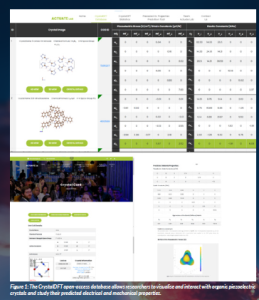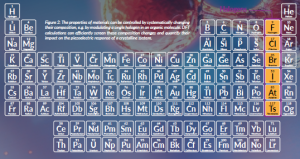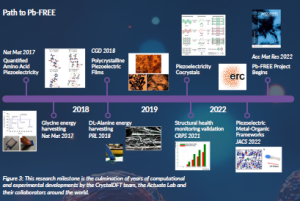Researchers at the University of Limerick in Ireland are using predictive modelling tools based on quantum mechanics to generate a database of the material properties of thousands of sustainable organic crystals.
The Actuate Lab, run by Dr Sarah Guerin in the Department of Chemical Sciences & Bernal Institute on the Wild Atlantic Way, recently published a landmark study of their ERC-funded research in the journal Angewandte Chemie. The paper presents the new open-access CrystalDFT database, now available to researchers in academia and industry at https://actuatelab.ie/CrystalDFT to discover materials for sensing and actuating applications (Figure 1).
The CrystalDFT project builds on almost ten years of Dr Guerin’s work using density functional theory (DFT) to study organic molecular crystals—an eco- friendly class of materials most commonly recognised as pharmaceutical drugs and biomolecules such as aspirin, collagen and vitamin B. However in recent years they have received growing attention as piezoelectric energy harvesters—meaning that they can efficiently convert mechanical energy into electrical energy due to their specific crystal structure and molecular arrangements. This has been particularly exciting as the commercial landscape of piezoelectric sensors, actuators and energy harvesters is
dominated by lead-containing ceramics (lead zirconium titanate, PZT) and fluorinated polymers (polyvinylidene-fluoride, PVDF), both of huge concern for human health and the environment. The Actuate Lab models, grows and integrates organic crystals as a low-cost alternative and sustainable class of piezoelectric material, to rival and potentially phase out environmentally damaging ceramics and polymers.
Piezoelectricity is an anisotropic property, so the amount of useful energy generated (or sensing/actuating efficiency and sensitivity) can increase or decrease in an individual crystal depending on the direction and type of mechanical input. DFT can quantify the piezoelectric response in all directions, which can provide crucial information for experimentalists when integrating these materials into functional devices. This tool has led to the discovery of high piezoelectricity in a large number of biological molecular crystals, and was the basis for Dr Guerin’s ERC grant Pb-FREE (Piezoelectric Biomolecules for Lead-Free, Reliable, Eco-Friendly Electronics). Because DFT needs only the nanoscale unit cell of the crystal to predict these properties, it also allows us to rationalise and understand what causes high piezoelectricity at the atomic level. Just look at the Actuate Lab’s recent study on halogen-mediated piezoelectricity in collaboration with Pondicherry University in India (Kumari et al., 2025). Here, just one molecule was studied, but its piezoelectric response could be induced, and then dialled up or down by changing a single atom. When the base molecule is crystallised, it has no piezoelectricity due to the symmetry in the crystal unit cell. But change one hydrogen to a halogen? The symmetry is broken, and the crystal is now piezoelectric! Move down the periodic table (Figure 2), and change your halogen atom from chlorine to bromine to iodine? This can change the flexibility and electrical charge in the unit cell—the two ingredients for piezoelectricity. This combined use of computational and synthetic chemistry is becoming more commonplace in the field of crystal engineering and in the study of these kinds of ‘structure-property relationships.’ Dr Guerin and her team, alongside experimental collaborators around the world, have been modelling, discovering and engineering molecular crystal piezoelectrics like this on a case-by-case basis until now.
It takes a village
A number of development stages led to the now 1200 crystal-strong CrystalDFT database, alongside the breadth of modelling and experimentation carried out prior to ERC funding (Figure 3). The first was the work of senior author Dr Pierre Cazade in using the software CP2K to break through the unit cell size limit for experimentally accurate piezoelectric predictions. This is demonstrated in a 2021 paper (O’Donnell et al., 2021) where the properties of two protein crystals could be predicted and verified experimentally—a three-order-of-magnitude increase in unit cell size with the same quantitative accuracy. This required lifting the hood on DFT software and examining the underlying mathematics, which was key to developing the Crystools package for automated DFT material property screening.
Alongside this, co-author Robert Guest, then an undergraduate student completing his final year project in Dr Guerin’s group, was tasked with automating the workflow of the three-step process to calculate the piezoelectric properties of a single molecular crystal. Six months later, this was cracked with an automated script that removed all of the manual labour of file preparation, transfer, data analysis, and even automating the checks and balances to ensure the calculation had run correctly. The properties of a hundred crystals could be calculated in parallel in the same time as one, and the stage was set for an efficient and accurate high-throughput screening of a hugely diverse chemical space.
Enter the ERC-funded team of Geetu Kumari and Dr Shubham Vishnoi, with backgrounds in DFT calculations of ferromagnetic materials, and molecular dynamics modelling of peptide therapeutics (such as the now infamous GLP-1 drug class), respectively.
Together they have become a high-throughput screening powerhouse that has generated and analysed the core CrystalDFT database, as well as a plethora of other sub-classes such as metal-organic frameworks, hydrates and racemates, all set for publication over the course of 2025. Dr Vishnoi’s experience in scientific website and interface development spurred him to realise the final piece of the puzzle proposed in the Pb-FREE ERC proposal, written in 2021 at the height of the COVID-19 lockdown: CrystalDFT as an open-access database and community resource. Version 1.0 has the full spectrum of piezoelectric, mechanical and dielectric properties for the first bout of crystal structures.
What is the current state of the art?
High-throughput DFT involves analysing hundreds to tens of thousands of compounds, necessitating novel calculation and data management approaches. In the broad field of materials science, applications of high-throughput DFT have led to the development of several comprehensive databases, including AFLOW, Materials Project, Open Quantum Materials Database (OQMD) and NIST-JARVIS. These databases catalogue computed geometries and various physicochemical properties, facilitating the exploration of new materials. Specific to piezoelectric and dielectric materials, the databases developed have laid the groundwork for the resources provided in this work. DFT is also used in the field of crystallography to predict the number of different crystal structures, or polymorphs, that one molecule can form, which also provides candidate materials for experimentalists to explore while developing a high-accuracy, reproducible computational workflow.
Data, data, everywhere…
When generating this much data on a new class of energy-generating materials, screening and discovery isn’t enough. The real name of the game is design rules, and in the Angewandte Chemie work, you will see the start of this—statistical analysis of the chemical features embedded in each unit cell. Because piezoelectricity is a complex and multidirectional property, this data provides invaluable insights across a diverse chemical space. And (spoilers) provides a consistent source of training data for machine learning algorithms to see if they can predict piezoelectric responses without the need for computationally-intensive DFT calculations.
So what’s next?
The Actuate Lab team have achieved their initial goal of developing a systematic high-throughput computational approach to screening non-centrosymmetric organic molecular crystals for piezoelectricity, leading to the development of CrystalDFT, a database of DFT-predicted electromechanical properties. By applying a consistent computational framework across a diverse chemical space, they have identified promising candidates with significant piezoelectric coefficients. The computational team are now focusing on expanding the breadth and depth of the CrystalDFT database, while discovering materials for in-house crystallographers, materials scientists and electrical engineers to develop into functional and sustainable devices.
Beyond identifying high-performing materials, this approach establishes a scalable methodology for systematic comparison and analysis, ensuring reproducibility and laying the groundwork for further experimental validation and material optimisation. This baseline screening provides a foundation for future studies by crystal engineers around the world, including the exploration of more complex biomolecular systems and the integration of machine learning to enhance predictive accuracy. Ultimately, this work contributes to a structured, data-driven strategy for advancing organic piezoelectric materials and cements molecular crystals as an exciting class of customisable energy harvesters. It is particularly crucial for industry leaders in MedTech and beyond to not only have trust in the reliability of molecular crystal piezoelectricity but also to see the unique opportunities for application-tailored electromechanical properties and performance.
References
Hunnisett, L.M., Francia, N., Nyman, J., Abraham, N.S., Aitipamula, S., Alkhidir, T., Almehairbi, M., Anelli, A., Anstine, D.M., Anthony, J.E., Arnold, J.E., Bahrami, F., Bellucci, M.A., Beran, G.J.O., Bhardwaj, R.M., Bianco, R., Bis, J.A., Boese, A.D., Bramley, J., Braun, D.E., Butler, P.W.V., Cadden, J., Carino, S., Červinka, C., Chan, E.J., Chang, C., Clarke, S.M., Coles, S.J., Cook, C.J., Cooper, R.I., Darden, T., Day, G.M., Deng, W., Dietrich, H., DiPasquale, A., Dhokale, B., van Eijck, B.P., Elsegood, M.R.J., Firaha, D., Fu, W., Fukuzawa, K., Galanakis, N., Goto, H., Greenwell, C., Guo, R., Harter, J., Helfferich, J., Hoja, J., Hone, J., Hong, R., Hušák, M., Ikabata, Y., Isayev, O., Ishaque, O., Jain, V., Jin, Y., Jing, A., Johnson, E.R., Jones, I., Jose, K.V., Kabova, E.A., Keates, A., Kelly, P.F., Klimeš, J., Kostková, V., Li, H., Lin, X., List, A., Liu, C., Liu, Y.M., Liu, Z., Lončarić, I., Lubach, J.W., Ludík, J., Marom, N., Matsui, H., Mattei, A., Mayo, R.A., Melkumov, J.W., Mladineo, B., Mohamed, S., Momenzadeh Abardeh, Z., Muddana, H.S., Nakayama, N., Nayal, K.S., Neumann, M.A., Nikhar, R., Obata, S., O’Connor, D., Oganov, A.R., Okuwaki, K., Otero-de-la-Roza, A., Parkin, S., Parunov, A., Podeszwa, R., Price, A.J.A., Price, L.S., Price, S.L., Probert, M.R., Pulido, A., Ramteke, G.R., Rehman, A.U., Reutzel-Edens, S.M., Rogal, J., Ross, M.J., Rumson, A.F., Sadiq, G., Saeed, Z.M., Salimi, A., Sasikumar, K., Sekharan, S., Shankland, K., Shi, B., Shi, X., Shinohara, K., Skillman, A.G., Song, H., Strasser, N., van de Streek, J., Sugden, I.J., Sun, G., Szalewicz, K., Tan, L., Tang, K., Tarczynski, F., Taylor, C.R., Tkatchenko, A., Tom, R., Touš, P., Tuckerman, M.E., Unzueta, P.A., Utsumi, Y., Vogt-Maranto, L., Weatherston, J., Wilkinson, L.J., Willacy, R.D., Wojtas, L., Woollam, G.R., Yang, Y., Yang, Z. and Yonemochi, E. (2024) ‘The seventh blind test of crystal structure prediction: structure generation methods’, Acta Crystallographica Section B: Structural Science, Crystal Engineering and Materials, 80(6). doi: 10.1107/S2052520624008679.
Jain, A., Montoya, J., Dwaraknath, S., Zimmermann, N.E.R., Dagdelen, J., Horton, M., Huck, P., Winston, D., Persson, K.A. and Ong, S.P. (2020) ‘The materials project: accelerating materials design through theory-driven data and tools’, in Andreoni, W. and Yip, S. (eds.) Handbook of materials modeling: methods: theory and modeling. Cham: Springer, pp. 1751–1784.
Kumari, G., O’Mahony, C., Veluthaparambath, R.V.P., Bhattacharya, S., Saha, B.K. and Guerin, S. (2025) ‘Halogen and hydrogen bonded 2-X-pyridin-3-ol (X = Cl, Br, I) organic crystals with large shear piezoelectricity’, Matter [In press].
O’Donnell, J., Cazade, P.A., Guerin, S., Djeghader, A., Haq, E.U., Tao, K., Gazit, E., Fukada, E., Silien, C., Soulimane, T., Thompson, D. and Tofail, S.A.M. (2021) ‘Piezoelectricity of the transmembrane protein ba3 cytochrome c oxidase’, Advanced Functional Materials, 31(28), 2100884. doi: 10.1002/adfm.202100884.
Sabu, S., Mondal, S., Rahman, A. and Thomas, S.P. (2025) ‘From flexible crystals to piezoelectrics: the advent of a new class of flexible functional molecular materials’, Small, 21(20), e2412561. doi: 10.1002/smll.202412561.
Vishnoi, S., Kumari, G., Guest, R., Cazade, P.-A. and Guerin, S. (2025) ‘Highthroughput computational screening of small molecular crystals for sustainable piezoelectric materials’, Angewandte Chemie International Edition, 137(18), e202501232. doi: 10.1002/anie.202501232.
Project name
Pb-FREE
Project summary
Biomolecular crystals have emerged as exciting new, sustainable piezoelectrics. Until now, little research has focused on developing these crystals as reliable, solid-state sensors to integrate into conventional electronic devices, due to their water solubility, uncontrolled growth, variable response and electroding difficulties.
Pb-FREE is taking on the challenge of accelerating the design, growth and engineering of these eco-friendly piezoelectric materials through high-throughput computational screenings, novel crystal growth procedures and standardised electromechanical characterisation and packaging. In 2024, the project reported a confined and moulded crystallisation procedure that allows for chemistry-independent versatility in component shape and size.
Project lead profile
Dr Sarah Guerin runs the Actuate Lab in the Department of Chemical Sciences and Bernal Institute at the University of Limerick. She has secured over €2M of funding for her work on in-silico and ex-silico engineering of biomolecular crystals, primarily for eco-friendly sensing and pharmaceuticals. She works with research groups around the world to predict, understand and design the properties of functional molecular crystals. She is the 2023 Research Ireland Early Career Researcher of the Year.
Project contacts
Dr Sarah Guerin
Bernal Institute University of Limerick Castletroy
Limerick City Ireland
Email: guerinactuatelab@gmail.com
Web: actuatelab.ie
Linkedin: /sarah-guerin28/
Funding
This project has been funded by The European Research Council (ERC) under the European Union’s Horizon Europe research and innovation programme – grant agreement number 101039636.
Views and opinions expressed are however those of the author(s) only and do not necessarily reflect those of the European Union or the ERC. Neither the European Union nor the granting authorities can be held responsible for them.
Figure legends
Figure 1: The CrystalDFT open-access database allows researchers to visualise and interact with organic piezoelectric crystals and study their predicted electrical and mechanical properties.
Figure 2: The properties of materials can be controlled by systematically changing their composition, e.g. by modulating a single halogen in an organic molecule. DFT calculations can efficiently screen these composition changes and quantify their impact on the piezoelectric response of a crystalline system.
Figure 3: This research milestone is the culmination of years of computational and experimental developments by the CrystalDFT team, the Actuate Lab and their collaborators around the world.




